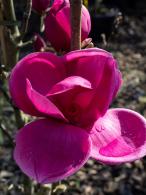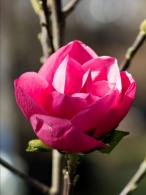Magnolia Venus
Profuse Peony-Shaped Purple Blooms
1. Add items to basket
2. Go to the basket
3. Enter your postcode in Delivery Price Check
To check delivery cost add your plants to basket, then you can type your postcode in our Quick Delivery Price Check.
Magnolia Venus is deciduous magnolia tree with profuse peony-shaped rich purple flowers in spring. It’s bred to bloom late thus avoiding damage to the blooms from spring frosts. This is a beautiful choice for a small specimen tree in urban and country gardens.
Magnolia are one of the oldest flowering plants. They appear in the fossil record dating back millions of years and were once widespread across the world. Nowadays, they are native to southern China and the southern United States.
Magnolia Venus was bred in Germany by Michael Gottschalk and introduced in 2017. It’s a cross between the very popular Magnolia Black Tulip and a variety of Magnolia Soulangeana. Magnolia Venus is prized for its profuse display of peony-shaped purple blooms. Because it’s a new cultivar, it was bred to flower later in April to avoid the frosts that damage so many early flowering magnolia buds.
This is a tree magnolia with a slow-growing upright trunk and mid-green matt foliage that emerges warm bronze after the flowers are spent. If you want a stunning specimen tree this is a good bet.
Height And Spread of Magnolia Venus
Magnolia Venus reaches a height and spread of four by three metres over ten years.
How Hardy Is Magnolia Venus
It’s hardy down to freezing temperatures if its roots are well drained, but it needs a sheltered spot to flower.
How To Use Magnolia Venus
Magnolia Venus is a good size for compact spaces and suits frost-free sheltered courtyards. In countryside gardens, it needs a sheltered spot, so near a wall-side border is best.
Its stunning purple flowers suit modern spaces, Japanese gardens, cottage borders and low-maintenance gardens.
How To Care For Magnolia Venus
Magnolia Venus is easy to grow. It prefers full sun to partial shade in neutral to acidic soil that’s well drained. A frost pocket free area that’s protected from cold winds is important.
Even though it’s bred to avoid spring frosts, any late frost may damage the buds. Its best to keep an eye on the forecast and if a hard frost is forecast, cover the tree in horticultural fleece.
Pruning isn’t necessary, but you can remove wayward branches after flowering or in the winter. Water it well until you see new growth and apply acidic-based mulch to the roots each spring.













